GenAge entry for HSPD1 (Homo sapiens)
Gene name (HAGRID: 159)
- HGNC symbol
- HSPD1
- Aliases
- GroEL; HSP60; SPG13
- Common name
- heat shock 60kDa protein 1 (chaperonin)
Potential relevance to the human ageing process
- Main reason for selection
- Entry selected based on evidence linking the gene product to a pathway or mechanism linked to ageing
- Description
HSPD1 plays a role in stress response in the mitochondria [753]. Heat-shock proteins have been suggested as a player in the ageing of model organisms such as invertebrates. Age-related changes in heat-shock proteins, including HSPD1, have also been reported in rats [1644]. A mutation in the human HSPD1 gene has been associated with spastic paraplegia [1713]. HSPD1's relevance to human ageing remains to be determined.
Cytogenetic information
- Cytogenetic band
- 2q33.1
- Location
- 197,486,584 bp to 197,499,916 bp
- Orientation
- Minus strand
Protein information
- Gene Ontology
-
Process: GO:0002368; B cell cytokine production
GO:0002755; MyD88-dependent toll-like receptor signaling pathway
GO:0002842; positive regulation of T cell mediated immune response to tumor cell
GO:0006458; 'de novo' protein folding
GO:0006919; activation of cysteine-type endopeptidase activity involved in apoptotic process
GO:0006986; response to unfolded protein
GO:0008637; apoptotic mitochondrial changes
GO:0009409; response to cold
GO:0016032; viral process
GO:0032727; positive regulation of interferon-alpha production
GO:0032729; positive regulation of interferon-gamma production
GO:0032733; positive regulation of interleukin-10 production
GO:0032735; positive regulation of interleukin-12 production
GO:0032755; positive regulation of interleukin-6 production
GO:0042026; protein refolding
GO:0042100; B cell proliferation
GO:0042110; T cell activation
GO:0042113; B cell activation
GO:0043032; positive regulation of macrophage activation
GO:0043065; positive regulation of apoptotic process
GO:0043066; negative regulation of apoptotic process
GO:0045041; protein import into mitochondrial intermembrane space
GO:0048291; isotype switching to IgG isotypes
GO:0050821; protein stabilization
GO:0050870; positive regulation of T cell activation
GO:0051131; chaperone-mediated protein complex assembly
GO:0051604; protein maturation
GO:0061077; chaperone-mediated protein folding
Cellular component: GO:0005615; extracellular space
GO:0005737; cytoplasm
GO:0005739; mitochondrion
GO:0005743; mitochondrial inner membrane
GO:0005759; mitochondrial matrix
GO:0005769; early endosome
GO:0005829; cytosol
GO:0005886; plasma membrane
GO:0005905; clathrin-coated pit
GO:0009986; cell surface
GO:0016020; membrane
GO:0019907; cyclin-dependent protein kinase activating kinase holoenzyme complex
GO:0030135; coated vesicle
GO:0030141; secretory granule
GO:0031012; extracellular matrix
GO:0043209; myelin sheath
GO:0043234; protein complex
GO:0046696; lipopolysaccharide receptor complex
GO:0070062; extracellular exosome
Hide GO termsFunction: GO:0001530; lipopolysaccharide binding
GO:0002039; p53 binding
GO:0003688; DNA replication origin binding
GO:0003697; single-stranded DNA binding
GO:0003725; double-stranded RNA binding
GO:0005515; protein binding
GO:0005524; ATP binding
GO:0016887; ATPase activity
GO:0031625; ubiquitin protein ligase binding
GO:0044183; protein binding involved in protein folding
GO:0044822; poly(A) RNA binding
GO:0051082; unfolded protein binding
GO:0051087; chaperone binding
Protein interactions and network
- Protein-protein interacting partners in GenAge
- MYC, PLCG2, BRCA1, PTEN, VCP, NR3C1, ABL1, EEF2, BAX, GRB2, APP, RAD52, SIRT1, HDAC1, HSPA9, GSR, HSPA1A, MAPK14, ATF2, HSPA8, ESR1, CLU, STUB1, PCK1, SIRT3, BAK1
- STRING interaction network
Retrieve sequences for HSPD1
Homologs in model organisms
- Caenorhabditis elegans
- hsp-60
- Danio rerio
- hspd1
- Drosophila melanogaster
- Hsp60C
- Mus musculus
- Hspd1
- Rattus norvegicus
- Hspd1
- Saccharomyces cerevisiae
- HSP60
- Schizosaccharomyces pombe
- hsp60

